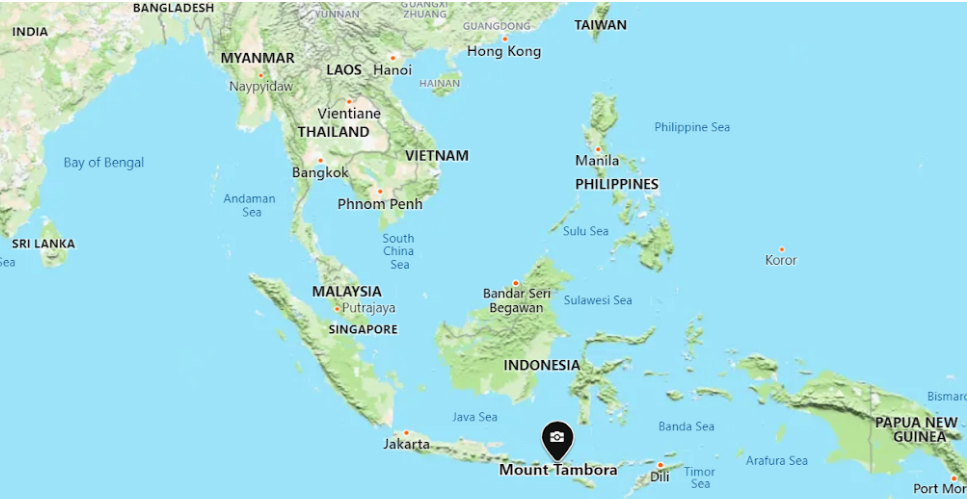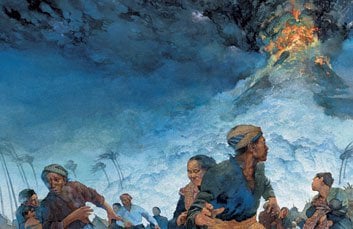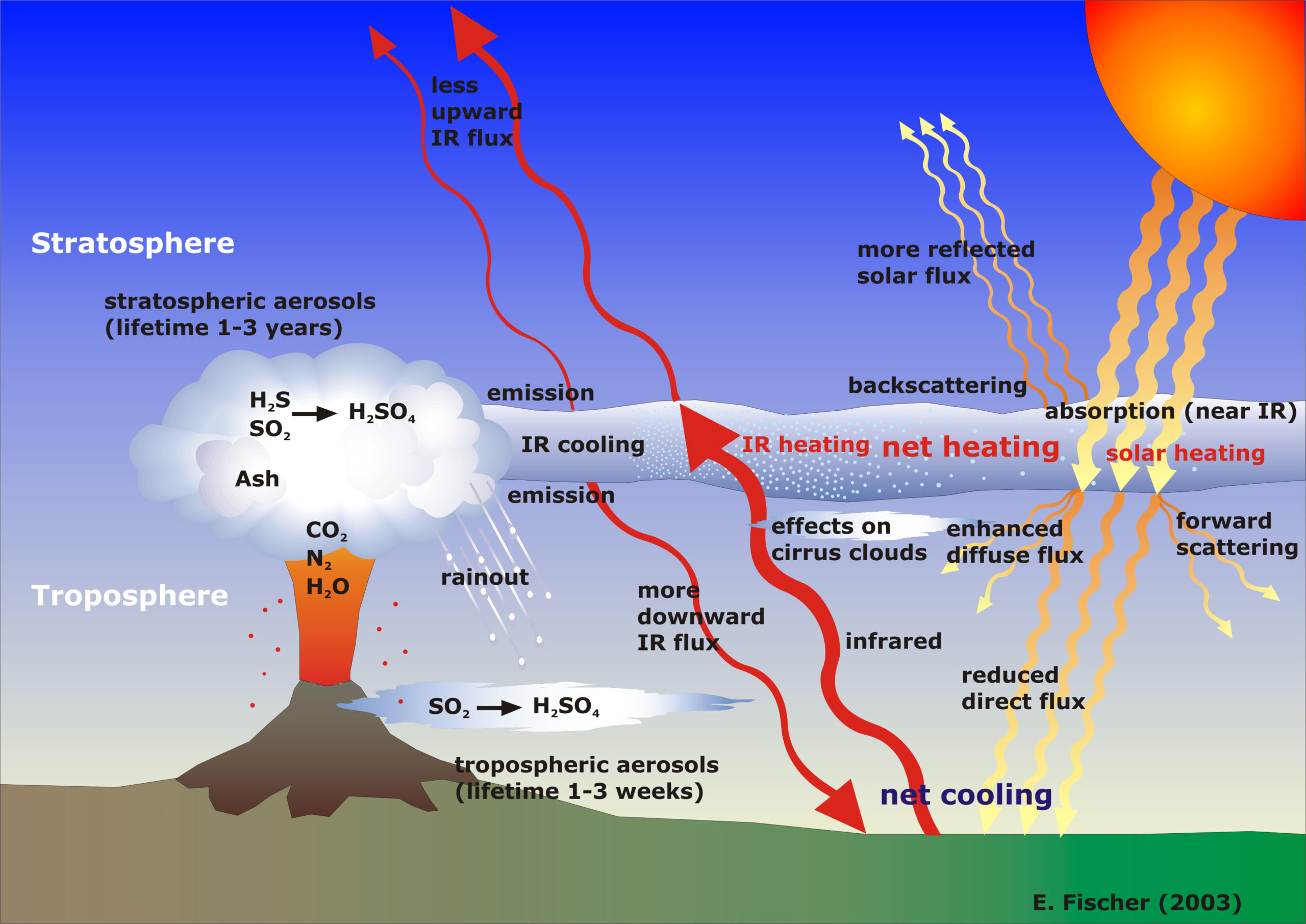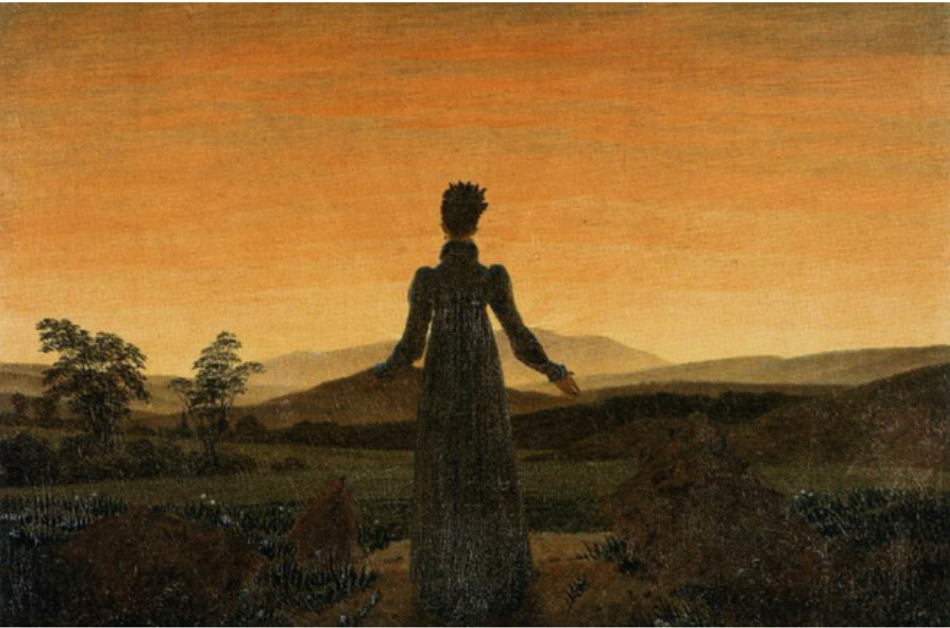
Aerial photograph of the present-day caldera of Mt. Tambora volcano in Indonesia (from Rafferty, 2018). The caldera is 6 to 7 kilometers (~4 miles) in diameter.
What happened?
- Mount Tambora (image above), a volcano on Sumbawa Island in present-day Indonesia (map below), erupted in April 1815. It was the most destructive explosion on Earth in the past 10,000 years. The volcano spewed 100 cubic kilometers (24 cubic miles) of gasses, dust, and rock into the atmosphere and the surrounding area.

Map of southeast Asia with the location of Mount Tambora in Indonesia indicated with a black marker (from Google Maps, 2021).
- 10,000 people living on the island were killed in the eruption (image below). News of this event traveled slowly because it occurred before the invention of the telegraph. For this reason, this eruption is generally less well known compared to the 1883 eruption of Krakatau (also known as Krakatoa) on an island between Java and Sumatra in present-day Indonesia, despite being 10 times more powerful.

Greg Harlin, American, n.d.–present. Great Eruption, 2002. Watercolors. Wood Ronsaville Harlin Inc. Smithsonian Magazine. This painting shows people on the island of Sumbawa, Indonesia fleeing from the eruption of Mount Tambora.
How is it related to climate?
- Smoke released by the volcano led to the most devastating sustained period of extreme weather in thousands of years. Small ash particles were released into the stratosphere (mid-level atmosphere), blocking solar radiation and absorbing heat. This reduction in sunlight cooled the troposphere (lower atmosphere), causing a volcanic winter that dropped global temperatures by 3°C (5.4°F) on average (image below).
- This volcanic winter was further amplified by other volcanic activity a few years before the eruption of Mount Tambora. In 1814, the Mayon Volcano erupted in the Philippines. Smaller volcanic eruptions also occurred between 1812 and 1813 in the Ryukyu Islands, Indonesia, and the Caribbean.

Diagram of how major volcanic eruptions affect climate (from Fischer, 2004). Stratospheric aerosols include fine volcanic ash particles that make their way high in the atmosphere and have a prolonged effect on global climate by reflecting solar radiation and trapping heat. As a result the ground receives less heat and sunlight, creating a cooling effect. (note: IR = infrared)
- In his book “Tambora: The Eruption That Changed the World,” Gillen D’Arcy Wood argues that the effects of the eruption and the ensuing climate disaster can be traced long into the 19th century. He emphasizes the interdependence of human and natural systems, pointing out that the eruption of Mount Tambora is only the most recent event of its kind, geologically speaking. The eruption provides a useful case study for understanding abrupt shifts in climate, weather extremes, and the link between volcanism and extreme weather events.
Global Impacts of the Eruption of Mount Tambora
- The eruption has been linked to a three-year-long weather disaster across the globe, in which crops failed due to cold weather and limited sunlight. The eruption brought drought, famine, and cold weather to many regions. Much of the world suffered and 1816 was known as the “Year without a Summer.”
Europe
- The eruption of Mount Tambora happened directly after the end of the Napoleonic Wars which left continental Europe in destruction. As a result, Europe was hit especially hard by the 1816 Year without a Summer as temperatures decreased and precipitation increased. Food became scarce and there were many riots throughout the continent.
- The declining climate in Ireland led wheat, oat, and potato crops to fail resulting in a famine. The Year without a Summer coincided with a typhus outbreak, causing over 40,000 deaths.
- In the summer of 1816, writers spent lots of time indoors, taking shelter from the dreary weather. Some authors engaged in a writing contest that inspired Mary Shelley’s Frankenstein, John William Polidori’s The Vampyre, and Lord Byron’s Darkness.
- The volcanic ash in the atmosphere caused red-orange sunsets. Many paintings, including Caspar David Friedrick’s Woman Before the Rising Sun (image below), feature the odd hues of sunset in the years following the eruption.

Caspar David Friedrich, German, 1774–1840. Woman in Front of Setting Sun, c. 1818. Oil paint on canvas. Acquisition was funded by the German Center for The Loss of Cultural Property.
MUSEUM FOLKWANG.
The United States
- In 1816 New England (northeastern U.S.), the usual growing season was disturbed by snow and frozen soil well into the summer. Food prices rose dramatically, triggering a western migration. Many families were forced to move westward to Indiana and Illinois, where farming was less affected.
- The eruption of Mount Tambora triggered The Panic of 1819, the first major economic depression in the U.S. In 1819, heavy investments in western U.S. agriculture after the Year without a Summer were lost when harvests stabilized in Europe, reducing European reliance on U.S. grain exports.
Asia
- The eruption of Mount Tambora affected the environmental conditions and ecology of the Bay of Bengal just east of the Indian subcontinent, giving rise to the mutation of Bengal cholera. This disease quickly spread, killing tens of millions of people in a global pandemic that lasted until 1823.
- In eastern Asia and India, the monsoon season was disrupted. The Yunnan province of China endured a three-year famine (1815-1818) due to flooding and cold weather throughout the growing season.
- The devastation of the Yunnan province inspired writer Li Yuyang to revive the poetry of seven sorrows, an ancient Chinese poetry style describing injustices and tragedy through the senses.
- After the Yunnan famine, many local farmers began to grow poppies in the place of less reliable cash crops that failed. The Yunnan province became a major producer of the world’s opium.
Arctic
- The volcanic winter disrupted wind and currents in the Arctic, breaking up sea ice and icebergs. Whaling ships reported clear Arctic waters, renewing British interest in searching for the Northwest Passage, a shortcut between the Atlantic and Pacific Oceans. Although the sea refroze in 1818, the British continued looking for the Northwest Passage until the 1840s.
- In 1851, the HMS Investigator, a ship sent to rescue the Franklin expedition, wrecked in the Arctic (image below). This was Britain’s last effort at finding a shortcut between the Atlantic and Pacific Oceans.
- The eruption of Mount Tambora created drought conditions over the North American continent, reducing the amount of freshwater that entered the Atlantic Ocean. This disrupted ocean currents, which are driven by water salinity, causing the Arctic Ocean to briefly warm up and the Atlantic Ocean to cool down.
/https://tf-cmsv2-smithsonianmag-media.s3.amazonaws.com/filer/9b/29/9b297bb7-c8b8-49e2-8a9d-2293a1eed373/aabr003980.jpg)
S. Gurney Cresswell, English, 1827–1867. Critical Position of H.M.S. Investigator on the North Coast of Baring Island, c. 1851. Oil paint on canvas. Royal Navy. Royal Geographical Society.
References and additional resources
- Ames, H. “What Were the Effects of the Tambora Eruption?” Sciencing. April 2017. https://sciencing.com/were-effects-tambora-eruption-8063429.html.
- “Canadian team finds 19th Century HMS Investigator wreck.” BBC News. July 2010. https://www.bbc.com/news/world-us-canada-10793639.
- Evans, R. “Blast from the Past.” Smithsonian Magazine. July 2002. https://www.smithsonianmag.com/history/blast-from-the-past-65102374/.
- Fischer, E. “Volcanic forcing on European Climate.” Institute for Atmospheric and Climate Science. May 2004. http://iacweb.ethz.ch/staff/fischer/volcanic.html.
- Greshko, M. “201 Years Ago, This Volcano Caused a Climate Catastrophe.” National Geographic. April 2016. https://www.nationalgeographic.com/science/article/160408-tambora-eruption-volcano-anniversary-indonesia-science?rid=5280E96429FDDFD2AC388AFA8C6F7C5C&cmpid=org=ngp::mc=crm-email::src=ngp::cmp=editorial::add=SpecialEdition_Escape_20220607.
- McNamara, R. “The Year Without a Summer Was a Bizarre Weather Disaster in 1816.” ThoughtCo. March 2018. https://www.thoughtco.com/the-year-without-a-summer-1773771.
- Rafferty, J. “Volcanic winter.” Encyclopaedia Brittanica. November 2018. https://www.britannica.com/science/volcanic-winter.
- Shepherd, M. “How do volcanic eruptions affect global weather?” Forbes Magazine. September 2015. https://www.forbes.com/sites/marshallshepherd/2015/09/14/how-do-volcanic-eruptions-affect-global-weather/?sh=119fcbe85064.
- Turner, J. “1816 – The Year Without a Summer.” Professional Coin Grading Services. March 2020. https://www.pcgs.com/news/1816-the-year-without-a-summer.
- Wood, G. D. “Largest volcanic eruption in human history changed the 19th century as much as Napoleon.” The Conversation. April 2014. https://theconversation.com/largest-volcanic-eruption-in-human-history-changed-the-19th-century-as-much-as-napoleon-25098.
- Wood, G. D. “Tambora: The Eruption That Changed the World.” Princeton University Press. 2015.
- Wood, G. D.“The Volcano That Changed the Course of History.” Slate. April 2014. https://slate.com/technology/2014/04/tambora-eruption-caused-the-year-without-a-summer-cholera-opium-famine-and-arctic-exploration.html.
- Zielinski, S. “200 Years After Tambora, Some Unusual Effects Linger.” Smithsonian Magazine. April 2015. https://www.smithsonianmag.com/science-nature/200-years-after-tambora-volcano-eruption-unusual-effects-linger-180954918/.
